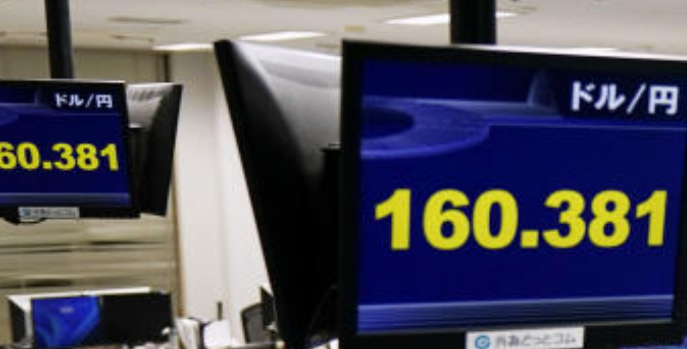The Japanese are busy preparing for another intervention for the Yen. Selling massive amounts of American bonds is their biggest weapon.
On June 26, the yen fell to its lowest level against the U.S. dollar since late 1986, driven by a significant interest rate differential between the U.S. and Japan. The U.S. dollar surged to 160.63 yen, the highest since December 1986, and last stood at 160.455 yen, up 0.5%.
Japan’s persistently low interest rates, compared to the higher rates in the U.S., have severely weakened the yen. On Wednesday, the 10-year Japanese government bond yield was 1.03%, while the 10-year U.S. Treasury yield was 4.304%. Eugene Epstein, head of structuring for North America at Moneycorp, noted that the market is naturally reacting to these rate differentials, regardless of Bank of Japan (BOJ) policies.
The Japanese yen hits weakest since in 38 years vs dollar. We are close! 🌊 pic.twitter.com/NhuvAeAM9l
— Rocky Morningside (@Jabeoux) June 26, 2024
Carry trade strategies, where investors borrow in low-yielding currencies like the yen to invest in higher-yielding assets, have gained popularity as global borrowing costs rise. Although Japan has slightly raised its interest rates to between 0% and 0.1%, the U.S. rates of 5.25% to 5.5% attract investors to dollar assets, boosting the dollar’s value against the yen.
Traders are testing the resolve of Japan’s Ministry of Finance and central bank, which spent $62 billion in April and May to support the yen when it dropped past 160. Japan’s top currency diplomat, Masato Kanda, expressed serious concern about the yen’s rapid decline, attributing it mainly to speculative activities.
Dollar hits 37-year high above 160.60 Yenhttps://t.co/9F7LBh09Vx
— Arab News Japan (@ArabNewsjp) June 26, 2024
Joe Tuckey, head of FX analysis at Argentex, commented that recent market reactions to official warnings have been muted, as they are not backed by rate changes. A potential BOJ rate hike in late July could support the yen, but a significant rally might require interest rate cuts from the Federal Reserve.
The dollar index, which measures the currency against six others, rose 0.2% to 105.92. Despite weaker-than-expected U.S. new home sales data, which fell 11.3% in May to an annual rate of 619,000 units, the dollar remained unaffected, adding to signs of a slowing U.S. economy.
Traders are closely watching Friday’s U.S. personal consumption expenditures (PCE) index, the Fed’s preferred inflation gauge. A lower-than-expected PCE could increase the likelihood of Fed rate cuts, potentially providing relief for the yen.
The euro declined 0.3% to $1.0686 after a European Central Bank (ECB) official suggested further rate cuts this year, contrasting with the Fed’s stance of no expected cuts in 2023. ECB governing council member Olli Rehn indicated that two more cuts this year seemed reasonable, while Fed Governor Michelle Bowman did not foresee U.S. rate cuts.
BREAKING: THE JAPANESE YEN 🇯🇵
EARLIER TODAY THE YEN HIT THE LOWEST PRICE AGAINST THE US DOLLAR SINCE 1986 pic.twitter.com/IQpj2Gsyp2
— GURGAVIN (@gurgavin) June 26, 2024
Australian inflation accelerated to a six-month high of 4% in May, prompting expectations of a rate hike by November. The Australian dollar rose 0.2% to $0.6659 against the U.S. dollar. Meanwhile, the British pound fell 0.3% to $1.2646.
China’s yuan also felt the pressure from the strong dollar, hitting a seven-month low of 7.2671 per dollar, with the central bank appearing tolerant of a weaker currency by gradually lowering the yuan’s daily trading range midpoint. The dollar remained stable at 7.2667 yuan.
Key Points:
i. The yen fell to its lowest level against the U.S. dollar since 1986, driven by a significant interest rate differential between Japan and the United States.
ii. Japan’s low interest rates (10-year bond yield at 1.03%) compared to the U.S. (10-year Treasury yield at 4.304%) are weakening the yen, encouraging carry trade strategies.
iii. Traders are testing the resolve of Japan’s Ministry of Finance and central bank, which previously spent $62 billion to support the yen when it dropped past 160.
iv. The dollar index rose 0.2% to 105.92, with weaker-than-expected U.S. new home sales data not affecting the dollar significantly, and traders closely watching the upcoming PCE index.
v. Other currencies like the euro and yuan also faced pressure, with the euro declining due to ECB rate cut talks and the yuan hitting a seven-month low, while Australian inflation prompted rate hike expectations.
Fallon Jacobson – Reprinted with permission of Whatfinger News



